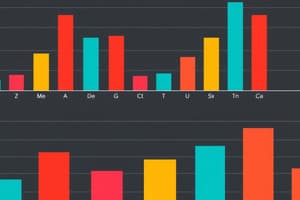Podcast
Questions and Answers
Which of the following is a primary application of bar charts?
Which of the following is a primary application of bar charts?
- Displaying changes over time
- Comparing sales figures across different products (correct)
- Representing continuous data distribution
- Showing precise numerical values
Bar charts are the best choice for displaying changes over time.
Bar charts are the best choice for displaying changes over time.
False (B)
What is a common limitation of bar charts?
What is a common limitation of bar charts?
They can present a cluttered display with excessive data categories.
Bar charts are less effective for showing ______________ values.
Bar charts are less effective for showing ______________ values.
Match the type of chart with its primary use:
Match the type of chart with its primary use:
What does the height or length of a bar in a bar chart represent?
What does the height or length of a bar in a bar chart represent?
A grouped bar chart displays data for a single variable across different categories.
A grouped bar chart displays data for a single variable across different categories.
What is the main purpose of using a bar chart?
What is the main purpose of using a bar chart?
In a bar chart, the x-axis typically represents ______.
In a bar chart, the x-axis typically represents ______.
Which of the following is NOT a component of constructing a bar chart?
Which of the following is NOT a component of constructing a bar chart?
Match the types of bar charts with their descriptions:
Match the types of bar charts with their descriptions:
A stacked bar chart can be used to identify trends or patterns easily.
A stacked bar chart can be used to identify trends or patterns easily.
What should you ensure for clarity when constructing a bar chart?
What should you ensure for clarity when constructing a bar chart?
Flashcards
What is a bar chart?
What is a bar chart?
A bar chart is a visual representation of data that uses bars of different heights to show the frequency or magnitude of categories.
When are bar charts used?
When are bar charts used?
Bar charts are ideal for comparing categories, like sales of different products, student grades in different subjects, or market share of various companies.
What is a limitation of bar charts?
What is a limitation of bar charts?
Bar charts are not suitable for showing changes over time. Line graphs are better for that purpose.
What can make a bar chart difficult to read?
What can make a bar chart difficult to read?
Signup and view all the flashcards
How do bar charts compare to other chart types?
How do bar charts compare to other chart types?
Signup and view all the flashcards
What is Categorical Data?
What is Categorical Data?
Signup and view all the flashcards
What is a Simple Bar Chart?
What is a Simple Bar Chart?
Signup and view all the flashcards
What is a Grouped Bar Chart?
What is a Grouped Bar Chart?
Signup and view all the flashcards
What is a Stacked Bar Chart?
What is a Stacked Bar Chart?
Signup and view all the flashcards
How do you Interpret Bar Charts?
How do you Interpret Bar Charts?
Signup and view all the flashcards
How do you Identify Trends in Bar Charts?
How do you Identify Trends in Bar Charts?
Signup and view all the flashcards
How do you Draw Conclusions from Bar Charts?
How do you Draw Conclusions from Bar Charts?
Signup and view all the flashcards
Study Notes
Introduction to Bar Charts
- Bar charts are graphical representations of categorical data.
- They display data using rectangular bars (or columns) whose heights or lengths correspond to the values of the variables.
- Each bar represents a specific category or group, and the height/length indicates the magnitude of the corresponding value.
- Bar charts are effective for comparing the values across different categories.
- Categorical data is data that can be grouped into categories or groups (e.g., types of fruits, colors of cars).
Constructing a Bar Chart
- Identify the variables: Determine which variable will be represented on the x-axis (categories) and the y-axis (values).
- Determine the scale: Choose the appropriate scale for the y-axis to accurately represent the values.
- Create the bars: Draw rectangular bars for each category, with their heights or lengths corresponding to the respective values on the y-axis.
- Label the axes: Clearly label both the x-axis (categories) and the y-axis (values) with appropriate titles.
- Provide a title: Give the chart a descriptive title that summarizes the data displayed.
- Add a key (optional): Use a key to further clarify the meaning of different colors or patterns used in the bars if applicable.
- Ensure clarity: Use clear labels, appropriate scales, and visual elements to make the chart easy to understand.
Types of Bar Charts
- Simple Bar Chart: Displays the data for a single variable across different categories.
- Grouped Bar Chart: Compares the values of multiple variables across different categories in a single chart. It uses separate bars within each category to represent the different variables being compared.
- Stacked Bar Chart: Shows the contribution of multiple variables in each category in a single chart. The bars are stacked vertically, and each section of the bar represents a different variable's contribution to the total.
Interpretation of Bar Charts
- Identify the highest and lowest values: Examine the bars to determine which categories have the highest and lowest values.
- Compare categories: Analyze the heights or lengths of the bars to compare the values of different categories.
- Identify trends or patterns: Look for any patterns or trends in the data displayed by the chart.
- Draw conclusions: Based on the analysis, draw informed conclusions about the data represented.
Bar Chart Applications
- Comparing sales figures across different products
- Showing the distribution of student grades
- Displaying market share of different companies
- Presenting population data for different regions
- Visualizing the number of people with different preferences
- Analyzing the performance of teams across various metrics.
Limitations of Bar Charts
- Bar charts are not suitable for showing changes over time.
- They may not be the best choice for displaying very large quantities of data.
- They are less effective for showing precise numerical values.
- Excessive data categories can result in a cluttered display.
Bar Chart vs. Other Charts
- Bar charts are often better than line graphs for displaying categorical data.
- Histograms are used to display the frequency distribution of continuous data, not categorical data found in bar charts.
- Pie charts can show proportional data but may not be suitable for comparing quantities.
Studying That Suits You
Use AI to generate personalized quizzes and flashcards to suit your learning preferences.




